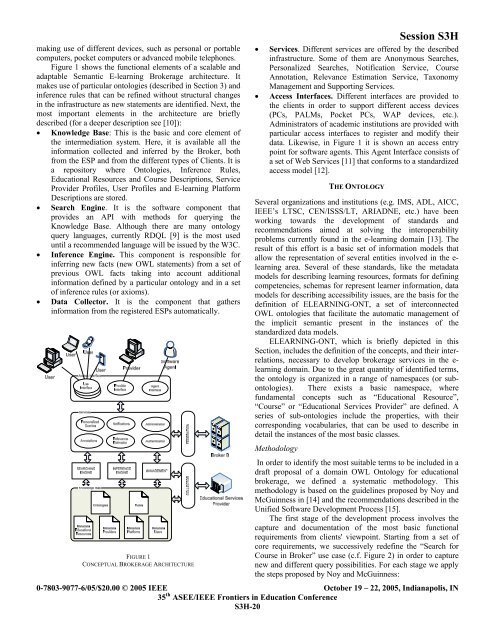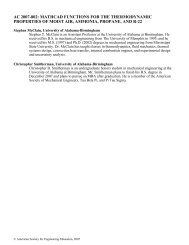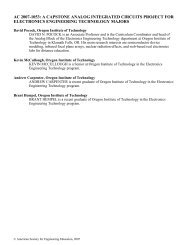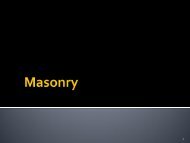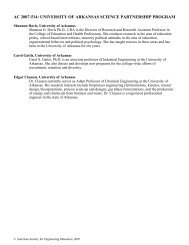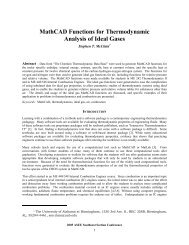Due to that problem, some solutions have beenimplemented that try to make it easier browsing Internet.These solutions are search engines and some examples couldbe Google or Yahoo!. It is clear that the <strong>Web</strong> would not havebeen the huge success it was, were it no for search engines.However, there are serious problems related to their use(identified in [3]):• It may happen that a search engine does not get anyanswer for a particular request (this is no frequent, but itis possible, in the most popular search engines) or resultsfrom the query do not include relevant pages (a morefrequent situation).• It <strong>of</strong>ten happens that a lot <strong>of</strong> mildly or lowly relevantresults are returned from a particular request. Even if themain relevant results are retrieved, they could be almostuseless if many others mildly relevant or irrelevantdocuments were also retrieved.• Very commonly the initial keywords queried do not getthe desired results because the relevant documents usedifferent terminology from the original query. This isunsatisfactory because semantically similar queriesshould return similar results. Results are highly sensitiveto vocabulary.• When the needed information is spread over several webresources, it is necessary to do several queries to gatherall the relevant documents, and then the partialinformation must be manually extracted and aggregated.The main obstacle to providing better support to <strong>Web</strong>users is that, at present, the meaning <strong>of</strong> <strong>Web</strong> content is notmachine-accessible. Although keyword-<strong>based</strong> techniques havehad an outright success, results from these engines can beimproved by conveniently describing the resources in thesearch space in a machine-readable way.The coming <strong>Semantic</strong> <strong>Web</strong> [4] is an extension <strong>of</strong> thecurrent web in which information in a machine-processableform can coexist and complement the existing human-readableinformation, better enabling computers and people to work incooperation.For the <strong>Semantic</strong> <strong>Web</strong> to function, facilities to putmachine-understandable data on the web must be developed.Ontologies [5] figure prominently in the emerging <strong>Semantic</strong><strong>Web</strong> as a way <strong>of</strong> representing the semantics <strong>of</strong> documents andenabling that semantics to be used by web applications andintelligent s<strong>of</strong>tware agents. An ontology defines the termsused to describe and represent an area <strong>of</strong> knowledge (likemedicine, tool manufacturing, automobile repair, financialmanagement, etc.), including computer-usable definitions <strong>of</strong>basic concepts in the domain and the relationship among them.They encode knowledge in a domain and also knowledge thatspans domains. In this way, they make that knowledgereusable.In order for ontologies to fulfil their role in the semanticintegration <strong>of</strong> the <strong>Web</strong>, there will need to be somestandardization <strong>of</strong> <strong>Web</strong> ontology languages. The W3C isalready moving in this direction with languages such as RDF(Resource Description Framework) and RDFS (ResourceSession S3HDescription Framework Schema). However, in order toachieve the widest possible acceptability, these languageshave deliberately been kept very simple and have relativelyweak semantics. Much richer ontology specification languagesare needed in order support the design, sharing and integration<strong>of</strong> the complex ontologies. Although during the last yearsvarious languages for the definition <strong>of</strong> ontologies have beenproposed [6], on February 2004 the W3C has standardizedOWL [7] as the language for the semantic description <strong>of</strong> <strong>Web</strong>resources.For the construction <strong>of</strong> a semantic LT Broker, we needthe definition <strong>of</strong> a specific ontology that includes all therelevant terms required to describe all the involved entities(courses, providers, clients, e-learning platforms, etc.).ELEARNING-ONT, an OWL integrative ontology will bedescribed in Section 3. Data collected from EducationalServices Providers and supplied by Clients will beconveniently transformed by the Broker into OWL statementsthat make use <strong>of</strong> the terms identified in ELEARNING-ONT.This transformation process, as well as other d<strong>edu</strong>ctive tasks(e.g. triggering <strong>of</strong> notification messages), is supported byinference rules, it is, axioms that specify an action if certainconditions are met. Currently, several rule languages coexist,but, for our prototypes, we use Notation 3 –or N3– [8] because<strong>of</strong> its simplicity: N3 is a simplified ontology language withsupport for rules and queries.Information stored in the Broker, as OWL statements, canbe queried through a semantic search engine. <strong>Semantic</strong> <strong>Web</strong>query languages, like RDQL [9], can be used to formulatecomplex queries in order to retrieve exactly the information inwhich we are interested. Subsequently a RDQL query isshown that would permit to locate the “courses” <strong>of</strong> “mediumdifficulty” on “literature” that are written in “Castilian”.SELECT ?a,WHERE (?a, , learn-ont:Course),(?a, ,lom-<strong>edu</strong>:MediumDifficulty),(?a, , “LITERATURE”,(?a, ,learn-ont-idiom:Castilian)It must be noted that courses declared to be written in“Spanish” will be also returned, because ELEARNING-ONTdefines that “learn-ont-idiom:Spanish” and “learn-ontidiom:Castilian”are equivalent.THE FRAMEWORKIn the LT brokerage context, Brokers collect the descriptions<strong>of</strong> the courses from the academic institutions, as well as thereferring contextual information in which they are delivered(data about the institution, delivering tools, dates forenrolment/delivery, etc.). These institutions or EducationalServices Providers (ESPs) should be registered in a Brokerand provide, among other data, the pr<strong>of</strong>ile <strong>of</strong> the institutionand the mechanism for accessing the catalogues <strong>of</strong> theproducts they <strong>of</strong>fer. The customers <strong>of</strong> a Broker can access tothe different services <strong>of</strong>fered by the intermediation system0-7803-9077-6/05/$20.00 © 2005 IEEE October 19 – 22, 2005, Indianapolis, IN35 th ASEE/IEEE Frontiers in Education ConferenceS3H-19
making use <strong>of</strong> different devices, such as personal or portablecomputers, pocket computers or advanced mobile telephones.Figure 1 shows the functional elements <strong>of</strong> a scalable andadaptable <strong>Semantic</strong> E-learning <strong>Brokerage</strong> architecture. Itmakes use <strong>of</strong> particular ontologies (described in Section 3) andinference rules that can be refined without structural changesin the infrastructure as new statements are identified. Next, themost important elements in the architecture are brieflydescribed (for a deeper description see [10]):• Knowledge Base: This is the basic and core element <strong>of</strong>the intermediation system. Here, it is available all theinformation collected and inferred by the Broker, bothfrom the ESP and from the different types <strong>of</strong> Clients. It isa repository where Ontologies, Inference Rules,Educational Resources and Course Descriptions, ServiceProvider Pr<strong>of</strong>iles, User Pr<strong>of</strong>iles and E-learning PlatformDescriptions are stored.• Search Engine. It is the s<strong>of</strong>tware component thatprovides an API with methods for querying theKnowledge Base. Although there are many ontologyquery languages, currently RDQL [9] is the most us<strong>edu</strong>ntil a recommended language will be issued by the W3C.• Inference Engine. This component is responsible forinferring new facts (new OWL statements) from a set <strong>of</strong>previous OWL facts taking into account additionalinformation defined by a particular ontology and in a set<strong>of</strong> inference rules (or axioms).• Data Collector. It is the component that gathersinformation from the registered ESPs automatically.FIGURE 1CONCEPTUAL BROKERAGE ARCHITECTURESession S3H• Services. Different services are <strong>of</strong>fered by the describedinfrastructure. Some <strong>of</strong> them are Anonymous Searches,Personalized Searches, Notification Service, CourseAnnotation, Relevance Estimation Service, TaxonomyManagement and Supporting Services.• Access Interfaces. Different interfaces are provided tothe clients in order to support different access devices(PCs, PALMs, Pocket PCs, WAP devices, etc.).Administrators <strong>of</strong> academic institutions are provided withparticular access interfaces to register and modify theirdata. Likewise, in Figure 1 it is shown an access entrypoint for s<strong>of</strong>tware agents. This Agent Interface consists <strong>of</strong>a set <strong>of</strong> <strong>Web</strong> Services [11] that conforms to a standardizedaccess model [12].THE ONTOLOGYSeveral organizations and institutions (e.g. IMS, ADL, AICC,IEEE’s LTSC, CEN/ISSS/LT, ARIADNE, etc.) have beenworking towards the development <strong>of</strong> standards andrecommendations aimed at solving the interoperabilityproblems currently found in the e-learning domain [13]. Theresult <strong>of</strong> this effort is a basic set <strong>of</strong> information models thatallow the representation <strong>of</strong> several entities involved in the e-learning area. Several <strong>of</strong> these standards, like the metadatamodels for describing learning resources, formats for definingcompetencies, schemas for represent learner information, datamodels for describing accessibility issues, are the basis for thedefinition <strong>of</strong> ELEARNING-ONT, a set <strong>of</strong> interconnectedOWL ontologies that facilitate the automatic management <strong>of</strong>the implicit semantic present in the instances <strong>of</strong> thestandardized data models.ELEARNING-ONT, which is briefly depicted in thisSection, includes the definition <strong>of</strong> the concepts, and their interrelations,necessary to develop brokerage services in the e-learning domain. Due to the great quantity <strong>of</strong> identified terms,the ontology is organized in a range <strong>of</strong> namespaces (or subontologies).There exists a basic namespace, wherefundamental concepts such as “Educational Resource”,“Course” or “Educational Services Provider” are defined. Aseries <strong>of</strong> sub-ontologies include the properties, with theircorresponding vocabularies, that can be used to describe indetail the instances <strong>of</strong> the most basic classes.MethodologyIn order to identify the most suitable terms to be included in adraft proposal <strong>of</strong> a domain OWL Ontology for <strong>edu</strong>cationalbrokerage, we defined a systematic methodology. Thismethodology is <strong>based</strong> on the guidelines proposed by Noy andMcGuinness in [14] and the recommendations described in theUnified S<strong>of</strong>tware Development Process [15].The first stage <strong>of</strong> the development process involves thecapture and documentation <strong>of</strong> the most basic functionalrequirements from clients' viewpoint. Starting from a set <strong>of</strong>core requirements, we successively redefine the “Search forCourse in Broker” use case (c.f. Figure 2) in order to capturenew and different query possibilities. For each stage we applythe steps proposed by Noy and McGuinness:0-7803-9077-6/05/$20.00 © 2005 IEEE October 19 – 22, 2005, Indianapolis, IN35 th ASEE/IEEE Frontiers in Education ConferenceS3H-20


